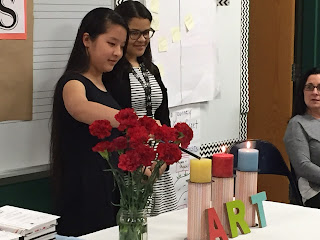After reading one of my new favorite art books, "The Noisy Paint Box" by Barb Rosenstock I couldn't help but have my second graders do their own music inspired painting. This was new for me, I hadn't tried it before so I wasn't sure how it was going to go, but I did know that second graders are still at an age where they are not afraid to jump right in to art without the fears of perfection that haunt my older students. So to begin I gave them each a black crayon and played some very well known classical pieces, they ranged from slow and soft to loud and exciting. I would name them, but I found a YouTube playlist that I skipped around in to give them a variety of emotion. I didn't get to see the names of all the pieces, but you can find the mix of classical music here. Students were on;y given one instruction, and that was to draw what they think the music looks like. I let them use both sides of the paper and then they chose the side they liked best. I think this was helpful because they had a chance to get used to it on the first side and try again on the other. I then provided students with water color paint to color in the whole paper. I think the students had a lot of fun creating these, and I had a lot of fun watching them. I love how each interpretation looks so different, and I really am impressed with how they came out!
















































